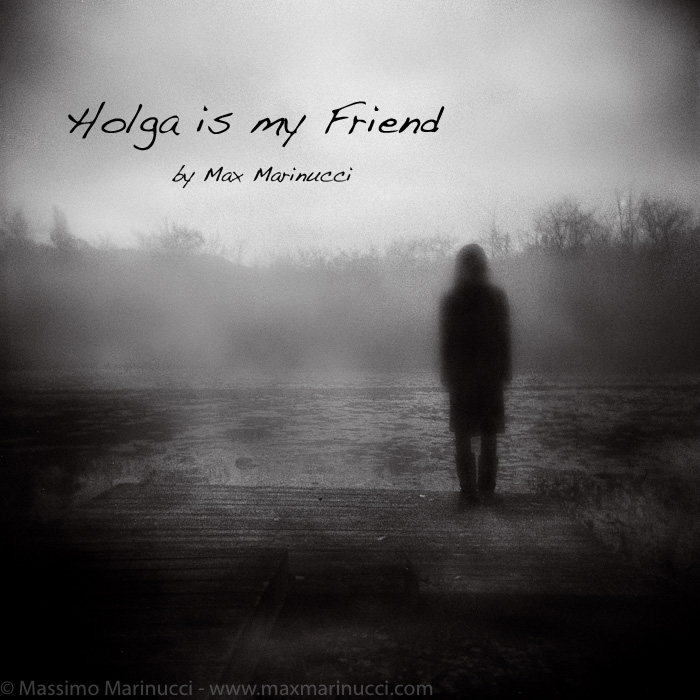
Holga is My Friend! By Max Marinucci
I always get a chuckle when I play with digital filters looking to emulate images taken with this iconic, inexpensive, plastic camera: add some vignette, bump up the blacks and…voila. Wrong!! No digital filter comes close to replicating images taken with a real Holga, for a variety of reasons. You may be able to get some approximations by doing extensive post processing but, I can assure you that, by the time you’re finished, you’d have realized that you might as well shoot the real thing with real film. After all, you have no excuse whatsoever…and no place to hide when you shoot with Holga and a roll of film. I mean we’re talking about $25 to $50 for this camera for goodness sake. After spending another $1000 on the latest, and soon to be obsolete digital toy, you can afford to spend $50 to learn, -experience, re-discover, something about basic photography. What you do get for $25-50 is an invaluable brain exercise in composition, exposure, light, pre-visualization, and most of all creativity. There is nothing there to bug you down or to distract. No menus, or a multitude of shutter speeds, apertures, dials, frame lines, beeps, flashing lights, batteries, NOTHING. It’s you, and that wondrous piece of plastic, all alone. If the resulting image sucks, it’s because YOU screwed up. It is as simple as that. You can’t hide behind Photoshop layers and all sorts of digital gimmicks. This is photography in its simplest form and your eyes/vision is what truly matters most. And yes, there are things you can screw up with Holga, but she won’t hold them against you.
First of all, well, it’s a cheap piece of plastic, made in China, with a simple meniscus lens. It is amazing that there is even a shutter and that it actually works (who knows for how long but who cares). Shutter speed is up for debate and may be off slightly from one example to the other so you will need to experiment a bit.
It is (supposedly) around 1/100, but it could be 1/60 or 1/125. It is just another one of those mysteries that keep Holga fanatics up at night, dreaming of their next shot. Aperture: sunny and not so sunny. Essentially, f11 and f8. Don’t know what the heck that means? Well, get off your lazy digital butt and figure it out. You will need a cheap (or expensive) incident light meter and work backwards after deciding which film you will use, to determine how you are exposing. There is a way to be a little lazier with Holga but I will touch on that later. If you want more control over your results (although that is a relative terms with Holga, since surprises are to be expected) then you will have to work a little harder for your prized images. Light leaks: if you are lucky, you get one that doesn’t have any (mine is okay, almost) but you will likely need some black electrical tape to minimize potential surprises (which could also be interesting, and that’s the beauty of this camera).
Film: let’s take the classic black & white emulsion, Kodak Tri-X. First of all, you’re working medium format here, so grain is not much of an issue, unless you’re pushing hard and printing very large. You are out on a beautiful sunny day, with a few clouds and you do want to bring those out a bit (if you wish). Slap one of those wonderful plastic yellow or orange filters on the lens and you’re ready. Tri-X @ box speed is 400ISO but you will lose one stop with a yellow filter (two with orange) so set your meter @200ISO and take a reading. Look at f11 and see what you got. Chances are that you will see a corresponding speed of 1/125. Magic! Sun behind the clouds a bit? No problem. Flip the little switch to the left on the camera and you have f8 at the same speed. When you develop your film based on 200ISO, and assuming your technique is correct, your negatives should be lovely. You have 12 frames to shoot so it’s easy to commit those to some sort of consistency over an outing, in terms of exposure. If they are all over the place (light-wise), well, obviously your negatives will reflect that. If you shoot part of the roll when light calls for 800ISO, some of your negatives will look underexposed. Again, don’t fret. Two stops of underexposure, in certain situations, may make those Holga shots still very moody and usable so don’t be overly concerned. I personally try to plan ahead and shoot a roll or two based on the weather and fairly consistent light. On a very cloudy day, with no shadows and shooting Tri-X, I will make believe I’m working @ 1250 ISO and develop accordingly. At that level, and with most developers, shadows will be blocked a bit but again that’s part of the Holga look so don’t worry about that, as a 1 1/2 stop push for Tri-X is nothing. I will also use Delta 3200 rated @ 1600 and pull development a bit, to get a different, Delta look, with rich blacks and bright highlights. A little more grain will be present but it all adds to the magic and beauty.
What Holga does: An Holga image doesn’t just add dark corners (vignette) and in fact, depending on lighting and exposure, those corners may not be very dark at all. It is also something you can burn a bit if you don’t love the look. The circle of sharpness from the lens is maybe one inch so you will see that everything in the center is pretty sharp and it gets softer as you go outward. This is what makes Holga images special and unique, along with a few other factors. You will be surprised that the lens will actually render quite a good amount of detail in the center and images will have a very 3D feel to it and this not something that a simple digital plug-in usually delivers.
Some people say that Holga images are “like a box of chocolates: you never know what you’re going to get.” It is true to some extent but it depends on how methodical you are. You can also put her on a tripod, with a $15 cable release (on Amazon), and slow film, set it to “bulb” and do long exposures with a timer, 1 Mississippi, whatever. Nothing is automatic or high tech here so it all does take a bit of brain effort. With 12 shots per roll (square 6×6), and a couple of rolls in your bag, you will also learn an exercise in restraint, as you want every one of those shots to count. Get in the mood, think atmosphere, mystery, pre-visualize, and be creative, because Holga can turn the mundane into art if you put some effort into it.
What Holga doesn’t do: make your coffee, laundry, cook meals, tethered shooting, clean 64000ISO, image stabilization, AWB, histograms nobody can read, give you files that you can turn into ten million images after spending days in Photoshop, etc.
Common mistakes: Double exposures! Ha, one of those mistakes that at times can turn another boring image into something special. Easy to forget to manually crank that high tech wheel counter-clockwise to advance to the next frame and…Superimpose another image to the one you took previously. Oops!
I try to use that to in a creative way and plan it (most of the time anyway), although images can turn out funky at times. Grain is usually more evident and there is a drop in contrast. After all you are exposing twice so, in theory, if one has a roll with all 12 frames of double exposures, development should be changed accordingly.
I don’t worry about it and adjust curves, dodge/burn in Lightroom if needed to bring the image where I want it to be (if possible). In a darkroom, the process would obviously be different, as you would have to play with exposure, different contrast paper and selective dodging/burning as well.
Development of your film: here we keep it simple as well. The classic combination of Tri-X and HC110 never fails to deliver and it is fast and easy. When developing for 200ISO, in a 500ml tank, I use a 1:50 dilution (that is 10ml of gooey syrup and 490ml of water) @ 68 degrees for 6 minutes flat. Five/six inversions upon closing the tank and then 3 gentle inversions over 10 seconds, every 30 seconds, for the remainder of the time. Stop, fix, wash, and hang to dry as usual. Great shadow detail and your highlights are sparkly but in check.
Shooting at an equivalent of 1250ISO? I have used XTOL, as it works well and it keeps grain manageable: 13.5 minutes @ 1:1 dilution. HC110 would also work well with the same 1:50 dilution, likely around 10-12 minutes…or stand develop in Rodinal 1:100 dilution for one hour. The possibilities are endless.
The less guesswork method: shoot Tri-X and develop in Diafine. Not much else to say, really. It’s a two-step/two bath process with no temperature concerns, for six minutes, and it works wonders with your friend Holga and Tri-X. The tonalities are different but the results are fairly predictable. The negatives scan and print wonderfully well.
Images:
Here is a double exposure shot. What I did here is base Tri-X @ 1250, use the f8 setting, composed and shot the main image, then flip the switch to f11 and shot the open sky/clouds. Result: instant fog. The image required some curves adjustments, a little boost in contrast, slight dodge/burn and it was ready to print within five minutes. A lot of mood, mystery here and I’m very happy at how this image turned out. It made a gorgeous print.
This is a similar shot but without a second exposure. No major adjustments here, as the film was slightly overdeveloped and the underexposure based on the 400ISO gave nice rich blacks naturally.
Here, my beautiful, and not so ever willing model (my daughter), for another pretty image at sunset by the lake. Taken with a Leica, it wouldn’t look this good!
Holga can make your landscapes beautiful as well. Here is a very close to sunset image, with fairly strong contrast. I have kept my agitation VERY gentle here, as I wanted to retain those highlights in the clouds. Again, with Tri-X and HC110 it is easy to do. It was very windy and the soft corners accentuated the movement in the grass to resolve in a very pleasing image.
Another landscape: taken also at the end of the day, I loved the way this tree extended its branch towards the path between the fences and framed the stone wall to end in the left corner. The blurry corners and at the edge of the left frame give the image a nice 3D peaceful, flowing look.
And one of my favorite images from this fall season: this gave me very much the feeling of a drawing/painting. Coming from an art background, I always frame my landscapes as I have a piece of canvas in front of me and this has a lovely chiaroscuro drawing feel. Those trees in the foreground seem to pop out and give a real sense of depth. This is a scan from a selenium/sepia toned print.
Now for REAL darkroom prints…HOLGA has no rivals when it comes to warm, moody, artistic interpretations! Don’t believe me? Check out my good friend and fellow photographer, the very talented Victor Milin and his wonderful lith prints here: www.vmilin.com. NYC and Venice never looked better!
I hope all of this inspires you to pick one up, with a few rolls of film..and make Holga your friend as well!
If you would like to browse more of my work, please check my website @ www.maxmarinucci.com, and also my Flickr page @ www.flickr.com/photos/leicaman/
[ad#Adsense Blog Sq Embed Image]

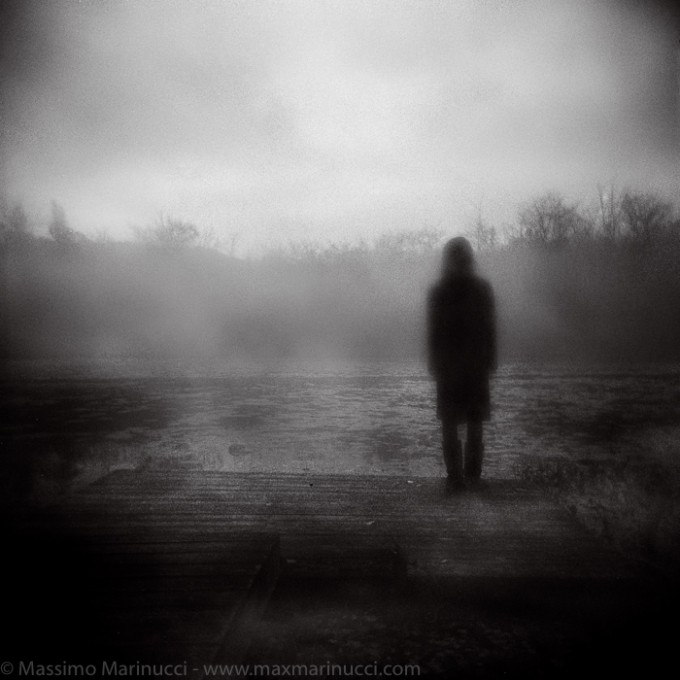
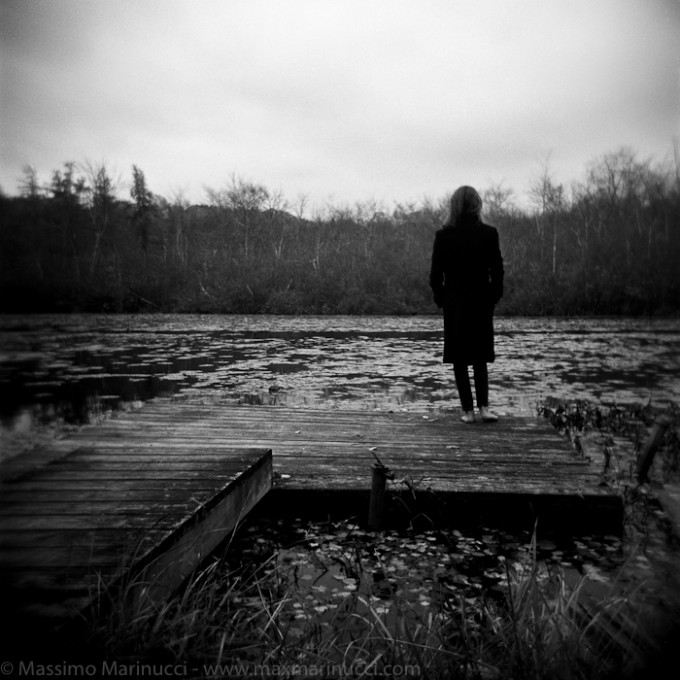
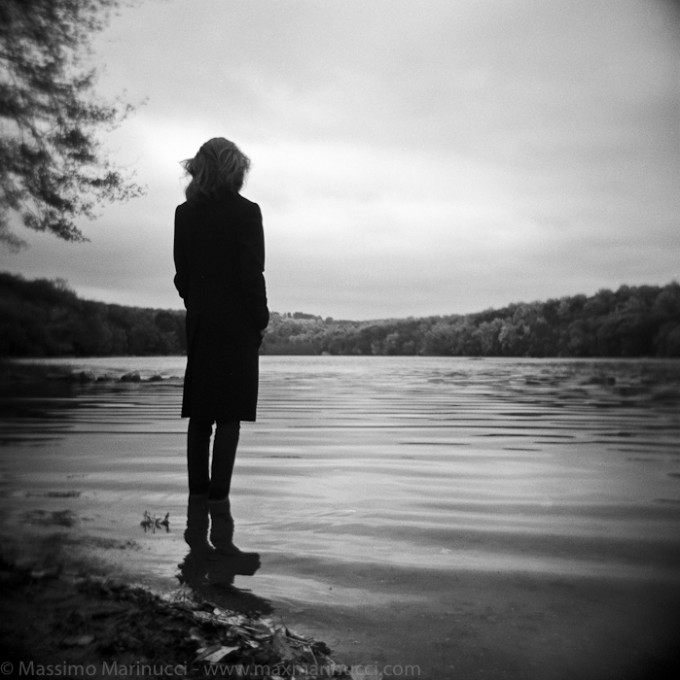
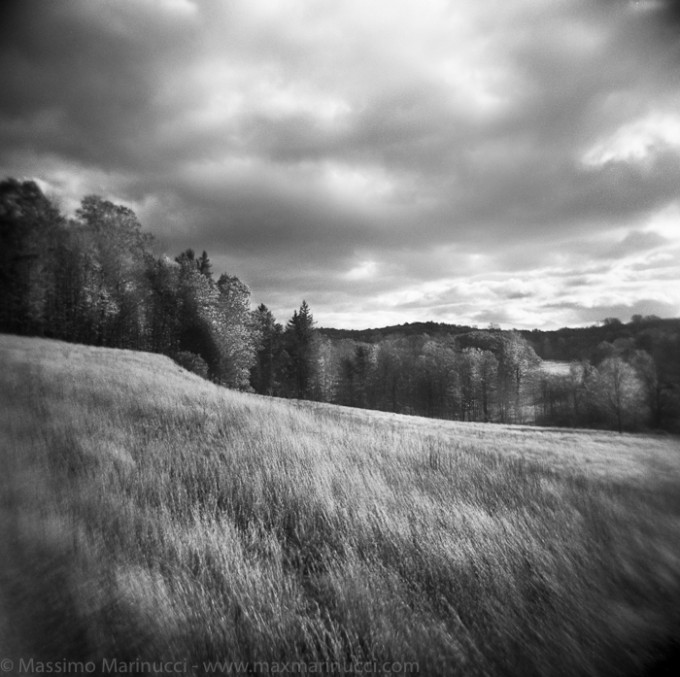
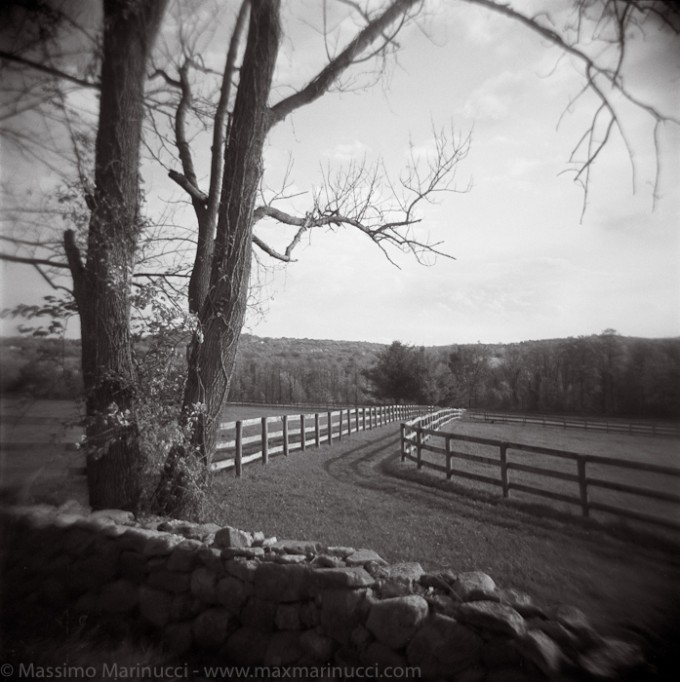
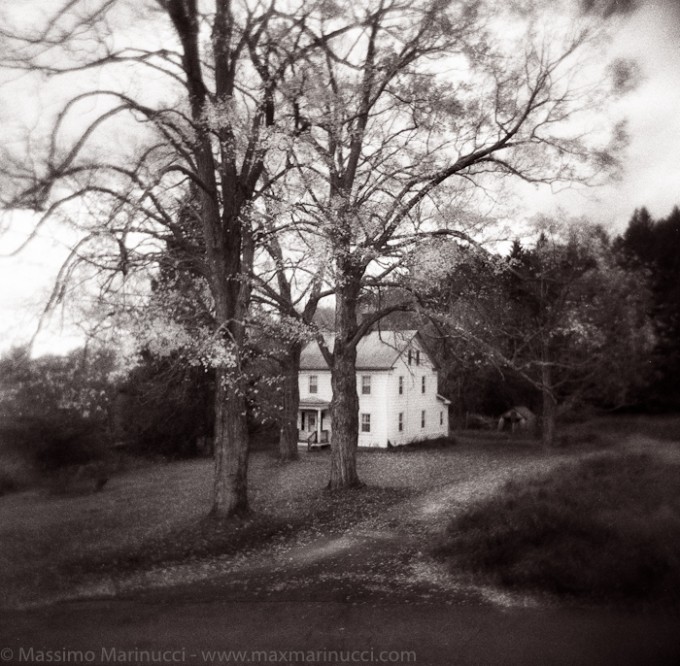


Thanks for the wonderful photos and the link to Victor Milin’s work. I’m amazed. To those who think that you can duplicate with digital, you don’t get it. Someone once wrote, “The closest thing to a Leica is a Holga”; easy to understand.
These are awesome!!.. Questions: what model of Holga you have ? Where can I buy B&W films, develop and print ? Looks like these are disappearing so fast..
A stock Holga has really only one working aperture…all you need do is look at the shutter/aperture mechanism with the back off and you will see what I’m saying…you need to do a hack to actually get two working settings.
You are a greata photographer ! i hate the olga !
Greg
Since I have mentioned my friend Victor Milin at the end of this article, if anyone is interested, some of his work will be displayed through December. If anyone is in the area or willing to take a trip, go check out the exhibit:
The Karen A. Garafalo Cultural Center at the Philmont Public Library will host photographs by Philmont resident Victor Milin.
Milin’s photographs of Venice, Italy, will be on view beginning November 1, 2010.
As digital photography pushes out the traditional photo processes, it’s becoming rare and specialized to work with large format manual cameras and toned black and white printing processes. Victor Milin uses a wonderful variety of old cameras and papers from Eastern Europe. This series of photographs of Venice, shot during the singularly quiet time that envelopes the city between Carnival and Spring, seeks to capture the private side of this unique and beautiful city, virtually unchanged for the last 400 years.
Milin will talk about this photos and eclectic photography process and equipment at the Philmont Library Cultural Center November 6 at 3 p.m.
Victor Milin is a photographer living in Columbia County. A native of New York City, Milin studied Photography at The School of Visual Arts, The International Center of Photography and John Coffer’s Camp Tintype. He has been a member of the Columbia County Council on the Arts since 2007 and is represented in corporate and private collections.
The Philmont Library hours are Monday 12-5, and 6-8, Tuesday closed, Wednesday 12-5 and 6-8, Thursday 10-2, Friday 12-5, Saturday 10-2. The Philmont Library is located at 101 Main Street (Route 217) in Philmont, NY.
Admission to the exhibition and artist talk is free.
Contact: Director, Karen Garafalo 518.672.5010
library@philmont. org
Isn’t 6 mins a little short/boarderline for tri-x? I read somewhere that 7 mins is min – so I took back my HC 110 and mixed D76…
Hey Richard..nope, absolutely not. Try it @ 200 and as described. The published Kodak times for HC110 are way off but this is tried and tested for dilution E. Also, this is increased agitation so it cuts the time down. You’re agitating every 30 seconds and not every minute. For portrait/street shots, and especially medium format, this particular method works wonders. Look at Sanders McNew’s work here http://www.flickr.com/photos/sandersnyc/
He uses exactly that exclusively and he actually agitates even more with 10-12 inversions at the beginning and then 3-4 quick inversions ever 30 seconds. For landscapes I back off a little but for people stuff, it’s absolutely perfect. Perfect highlights and awesome for skin tones.
..and frankly, for medium format, I don’t know why bother with anything else. Grain is not an issue and HC110 is cheap, easy to mix and lasts forever. Aside from getting more sharpness with XTOL and a nice curve with Rodinal, HC110+Tri-Xshot @200 and developed this way is perfect in my book. It’s fine with 35mm as well, but you’ll see a bit more grain. It doesn’t bother me, as I want even more and use Rodinal for 35mm.
Thank you both Max and Steve for your informative articles, I really enjoy this site. I’m looking forward to trying out the Holga 120N (ordered from B&H), and am crossing my fingers that I can get just a fraction of the wonderfulness out of it that you’ve shown us Max. (Victor’s work is also just dreamy)
Thanks, Aisha. Enjoy!!
Digital fans might try the Lensbaby plastic lens, for Nikon F and similar mounts. Also, there is a Nikon lens mount for Diana cameras as well.
Love the pictures…
Regarding your model, it’s no wonder she’s unwilling. She’s wearing an overcoat, so it must be cold, and standing in the water, which must be colder!
I had a similar model for about 17 years, but when she saw her opportunity to get away, she took it. Went away to college and never came back, except for Thanksgiving. 🙁 Probably just didn’t want her picture taken any more.
Paris, you are right 🙂 I have maybe another 4 years before she goes. Sad.
always wanted to order a Holga, gonna order mine tonight, this site is good at making me spend money (which is a good thing), cant wait to get a first roll though it.
I’ve got two Lomo Fisheye Cameras sitting somewhere. Next time I go to the beach, I’ll take that in addition to the MP.
Funny, but I think that the apeture switch actually has no function on a Holga, i.e. f8 and f11 are the same!
Hi Erik, it does on mine. I sometimes take two exposures of the same composition if it’s a shot I really want and there are differences. Also, when opening the back and looking at the diaphragm opening when triggering, the f8 setting is clearly larger.
Holgas used to be infamous for an aperture switch that didn’t work. However, apparently there was a Holga upgrade a little while back, and now the aperture switch works. Also, light leaks are less common. These cameras were originally designed as toy joke cameras for suckers. Now, their main business is serious photographers, and serious photographers get a little tired of light leaks and non-functional aperture switches eventually.
NL,
It all makes sense. Mine is more recent incarnation and the only light leak is from the frame counter window, which I need to keep masked with black tape. Also, the retaining clips for the back tend to fall off, creating a small issue, such as exposing film to light 🙂 so I tape those as well. Small inconveniences to deal with though, considering $25 and nice images.
Apparently there is a fixed hole that is around f/8. Even though the switch seems to work, it doesn’t change the fixed hole, just the holes on the movable plate. I got my Holgas from http://www.holgamods.com/ – no affiliation with them, but I liked their work so much I bought two more. He actually makes the apertures usable and has a bunch of other mods. Also has holga lens/body caps so you can attach a holga lens to your fancy DSLR.
Max – nice work. I’ve had limited success myself, need more practice!
Great images Max, saw a lot on your Flickr page too 🙂 I shot film for years, then digital and now I have come full circle back to film. I use digital for jobs and to be honest, I’m bored with it. It does not excite me or give anywhere near the satisfaction processing my own film and doing wet prints does.
I’m dying to try a Holga after seeing your shots, will get one soon, for the moment I’m shooting a Rolleiflex ‘baby’ 4×4 – what a beautiful bit of kit 🙂
Thanks, Andy. That is pretty much my story, although I have very little to show for my lost digital years, as creativity and inspiration was down the drain for the most part. Love those Rolleiflex, in any form. 🙂
Hey Max,
Great article. Way to use the real thing! Digital manipulation makes almost anything possible, but isnt it more fun to take pictures than to work on a computer?
Using digital manipulation to “attempt” to make other effects is such a drag, sure its possible, but how boring.
Hey Adam, thanks! Oh, I’m with you there. No time or patience to fiddle with raw files, plug-ins, filters, etc these days and I’d rather be out there shooting. Works for me…and, as you know, I like film better 🙂
Sorry, I missed you at PDN (read your flickr message too late) but I was there on Thursday. The Lightroom Workflow seminar was extremely interesting, I must say. Enjoyed the Epson booth with some amazing prints and Kodak giving away free Tri-X! 🙂
Max, I love your Holga pictures. I have a Holga with a Polaroid back, a Holgaroid. I don’t particularly like it because the film I was using was old, the thing jams quite a bit, and the actual picture was a circle in the middle of the 669 film. Plus, the film is rated at ISO 80, and wicked old. Makes for some very blue-ish shots…very dark.
Now, the Holga, on the other hand, is wonderful. Just using the Holga with 120 film yields some pretty cool results. I love the Diana cameras too. Holga also comes in a 35mm format, for those wishing to stick with 35mm film. I like the 6X6 myself. My local photo store, Iris Photo in Northampton, MA has a whole display of every Holga, Diana, and Lomo camera. I adore it. They even have a Diana kit, a full kit which includes filters and other stuff. I also get the Freestyle Photographic Supplies catalogs in the mail. What a cool catalog of stuff in there.
What would you recommend, if I don’t develop myself, a good lab to send to for B&W develop and putting on CD? I use Iris Photo right now, but would like to experiment with others.
Freestyle Link:
http://www.freestylephoto.biz/
Iris Photo Link:
http://www.iris-photo.com/
Hey Elaine, thanks! A decent lab can certainly do fine with your Holga negatives. You could even order a box of Diafine from Freestyle, give it to the lab and see if they can develop in that for you. I don’t see why they would refuse, as it is the easiest developer on earth to use and results are predictable.
Thanks for the article Max. This is great and your work, as always, is amazing.
One comment: It seems to me that you’re overdeveloping, based on your description of your process. If you start with Tri-X (ISO 400) and add a yellow filter, you do indeed lose a stop of light. In order to get proper exposure, then, one should overexpose the film as if it were ISO 200. When you expose the film as though it were ISO 200, you provide an extra stop of light, negating the light loss caused by the filter, and properly expose the film at ISO 400. (ISO 400 minus 1 stop for yellow filter, plus one stop of exposure when you expose as if the film were ISO 200, gets you right back to ISO 400 where you started.) So, if you develop as though you had pulled the film to ISO 200, you’re underdeveloping, which could result in a thin negative.
Not that it seems to have affected the beauty of your images. Just thought I’d point this out in case someone else decided to use your process and was confused with the final results.
Hey Brian, thanks! Actually, I use an incident light meter set @200 and work backwards to see if f8 or f11 fall in the 1/60 – 1/125 shutter speed range (supposed speed range anyway) of the camera. All of it, is really guesswork with the Holga anyway and using a compensating developer like HC110 or Rodinal helps balancing things out a bit. This is the reason why so many Holga shooter use Tri-X and Diafine. Not much to worry about there. Yes, since I do scan my work, I tend to pull a bit sometimes, as those negatives are easier to scan. Although that is debatable as well, since almost all of the images in my Shades of Reason gallery on my website are with Tri-X overexposed/overdeveloped (100-200) and Rodinal 1:25 for 11 minutes and those scan just beautifully (at least with my Nikon scanners).
Great article, Max! You’ve made me think differently about Holga’s. They are so prevalent on the streets of New York, that it’s easy to dismiss them as hipster fashion accessories. But I can see how they can be useful tools for making us get back to basics (moreso than a Leica M, even) and really think about what we are doing. You’ve put yours to great use; your shots are terrific.
Hi David..thanks! Holga is certainly a great tool, and again, so basic and simple.
The landscape images are beautiful, Max. You make the hole home film developement sound so easy. Well I will find out for my self in a month time. I have ordered chimicals, max, thanks for the insparation to try this out.
Thanks, Per. Let me know how it goes once you start your adventures in film developing!
i use an app called plastic bullet on my iphone and it gives me wonderful holga effects, it’s fun, not serious, breaks the tedium of waiting for m 35mm lux lens 🙂 http://www.flickr.com/photos/kiwicafe/5119652725/lightbox/
Fun app. Love my Hipstamatic though 🙂
Stunning work, Max. Holga used to it’s dreamiest strength. You are the master of film at SHP.com! As always, very inspirational
Thanks, Ashwin!
Beautiful photos!
Thanks, Mark!
Digital will not give you what a Holga can. It will still look like… well, digital that is trying to hard to be lo-fi. Holga’s often give you this whisper soft look that still looks harsh with digital. See Max’s last two images.
Here are some images that I took with my Diana +.
http://www.shawnhoke.com/tag/diana-f/
You have me hooked, going to search the internet for a Holga to go with my Noblex 🙂
love the work!
Thanks, Jim!
Hehe, funny enough I was at the Lomography store in London today!
..well, you better go back and pick one of these up 🙂
Truly an education into what is available just below the digital smoke screen. Thanks Max.
Thanks, Mr. B!
Max,
Think I loved these (almost) as much as the photos you took with your Leica in Korea (which is to say a lot). The last place near where I live that developed film seems to have vanished, but maybe if I hunt around!!?
Thanks, J. Well, the answer is…do it yourself. It’s easier than you think and it is fun. You can do color as well, easily, if you wish.
@Foggerty: At the size visitble on your screen, the beauty of scanned images from the Holga is probably not readily apparent. Also, with digital manipultion, the monkeying looked much more forced than the organic imperfections created by the Holga’s crap lens and silver halide capture. It would take a long time and a lot of expertise to make a digital capture look at beautifullly imperfect as a good holga image.
Another thing, if you take the Holga image and scan the 2.25″ negative in a coolscan 9000, you can end up with an 81 MP digital file (it will be like a 250 mb tiff to start!) that prints beautifully to 30×30 inches. I have used white house custom color (whcc.com) to do this and saw an amazing exhibit of agricultural and state fair images shot on a holga at the Griffin Museum of Photography in Belmont, MA (satellite museum), printed from scanned files by Digital Silver Imaging (print monochrome files onto real chemical BW paper). They were stunning. The same photographer also shot a few images and manipulated them in PS to get a Holga type look, but the effect was not quite the same, thought they were lovely.
Combining a lo-fi analog capture with the digital workflow can be incredibly satisfying and the results are truly different.
Foggerty, give it a try! The Holga is 20 bucks. If you don’t process film yourself you can send it via post to North Coast Photographic Service (ncps.com) and they can process it for you and send it back with a high res scan for a pretty reasonable price. You’ll be thrilled with the result! And, if not, youve lost just a few bucks.
Happy shooting to all,
Jay
Fantastic article. Perhaps the best I’ve seen from a Holga these days. Thank you for the dose of inspiration!
Thanks, Neo Wen!
Steve! I just went out and bought a Leica X1 based on your review and stunning photos. Now this!! You make me want to buy everything you write about. I’ve been tempted by a Holga before, being a Lomo LC-A owner but never took the leap. Great photos. But I think I’ll stick with the X1 for the moment! Great post though
Congrats on the X1 but you can blame Max for this one, he wrote the article on the Holga 🙂 Holgas are cheap though…$50?
Funny that I was pulling a roll of fm out of my holga just as I read this.
They are fun and prints from a nice Holga shot are amazing…ethereal, imperfect, and gorgeous.
Cheers,
jay
Yes they are, Jay. Perfection is certainly not a Holga thing but that’s what makes it special.
Nice shots but could just as well be digitally manipulated.
Foggerty, thanks. I am not disputing the fact that much can be achieved with digital manipulation but in this case, I just don’t see the point. First of all, I really don’t think a shot taken with, let’s say, a Leica lens can really be made to look like an Holga and, more importantly, it seems funny to me that some would go through the trouble and time using expensive digital gear to emulate a $25 plastic camera. Kind of ironic, wouldn’t you say? But, that’s how it is these days so, as always to each his own. 🙂
not completely, and not without a lot of work cause current presets out there for lightroom and such that ive seen and used dont come all that close.
Foggerty:
I think you missed the point of his article. If I’m not wrong, he even said it can be done digitally … but the fun and creativity that goes along with shooting a Holga not knowing exactly what you’ll get, having to wait and finding out that the image you took came out better than you expected or visualized!
My Holga: http://www.flickr.com/photos/scotthuckphoto/4115236913/in/set-72157622707317225/